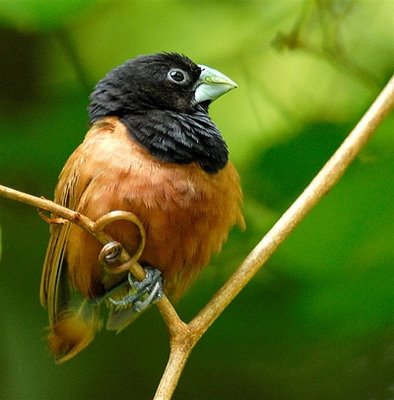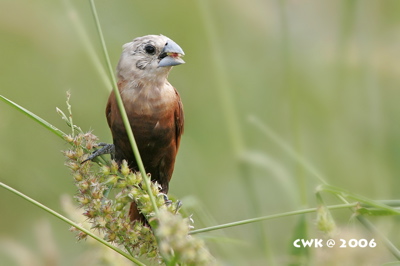Tailless Black-headed Munias
 Johnny Wee sent in a pair of images of the Black-headed Munia (Lonchura malacca), an adult (above) and a juvenile (below), both without tail feathers. The birds were seen at Upper Peirce Reservoir around early May 2006. This was a few days before the 12th, which was Vesak Day.
Johnny Wee sent in a pair of images of the Black-headed Munia (Lonchura malacca), an adult (above) and a juvenile (below), both without tail feathers. The birds were seen at Upper Peirce Reservoir around early May 2006. This was a few days before the 12th, which was Vesak Day.  The usual habitat of these birds include grassland, open field, parks and cultivated areas. Definitely not in the forested area where Johnny found them.
The usual habitat of these birds include grassland, open field, parks and cultivated areas. Definitely not in the forested area where Johnny found them.As the birds seemed out of place in a forested area, besides being tailless, Johnny was wondering whether someone had released them during Versak Day - after yanking out the tail feathers, for reasons best known to the devotee.
Can tail feathers be lost through natural moulting? Not according to ornithologist Wang Luan Keng: "Birds do not normally moult their complete set of tail feathers all at the same time. And these were not young birds…" Yes, in the tail, the central feathers are the first to be shed and as they grow back, successive feathers towards each side are moulted. Tail feathers function as a rudder, helping the bird to steer. They are also used in take-off and landing. When perching, these feathers help stabilise the bird in a wind. In the absence of tail feathers the bird can be disadvantaged in various ways, as when chased by a predator...
To release animals into a habitat that is alien to them does not help their survival. There have also been cases of marine animals being released into freshwater reservoirs and ponds. However, to yank out tail feathers from birds before releasing them is another matter.
 Comment by our bird specialist R. Subaraj: “Munias are regularly released, especially around our central reservoir areas where other munia species such as White-headed (Lonchura malacca) (above), Javan (Lonchura leucogastroides), White-rumped (Lonchura striata) and Scaly-breasted (Lonchura punctulata) (below) have also been noted. The loss of tail feathers is also a common sight and is probably due to their being housed in cramped, small cages with numerous other munias, as seen in various bird shops here. Buddhists are not likely to "yank" the feathers off during an act of kindness! Those who release animals into the wild mean well but are simply misguided, not realising the repercussions of their act."
Comment by our bird specialist R. Subaraj: “Munias are regularly released, especially around our central reservoir areas where other munia species such as White-headed (Lonchura malacca) (above), Javan (Lonchura leucogastroides), White-rumped (Lonchura striata) and Scaly-breasted (Lonchura punctulata) (below) have also been noted. The loss of tail feathers is also a common sight and is probably due to their being housed in cramped, small cages with numerous other munias, as seen in various bird shops here. Buddhists are not likely to "yank" the feathers off during an act of kindness! Those who release animals into the wild mean well but are simply misguided, not realising the repercussions of their act." Note: Vesak Day, also known as Buddha Day, is a major Buddhist festival usually celebrated in May, the month in which the Buddha was supposedly born, won enlightenment and passed into nirvana. During this period many Buddhists will release captive animals as an act of kindness, reflecting on the Buddha’s teaching of universal compassion.
Note: Vesak Day, also known as Buddha Day, is a major Buddhist festival usually celebrated in May, the month in which the Buddha was supposedly born, won enlightenment and passed into nirvana. During this period many Buddhists will release captive animals as an act of kindness, reflecting on the Buddha’s teaching of universal compassion.Input by Johnny Wee; Images by Johnny (Black-headed), Dr Jonathan Cheah Weng Kwong (White-headed) and KC Tsang (Scaly-breasted).
Labels: Miscellaneous



2 Comments:
What we can do to help is to educate the public that releasing captive animals into the wild is a wrong thing to do. Once the demand is no longer there, the captive animals suppliers will have to stop their trade.
Ashley Ng of Pigeon-Holes and his group of volunteers have been doing an excellent job every Vesak Day. They fan around various areas dissuading devotees from releasing animals etc.
Post a Comment
<< Home